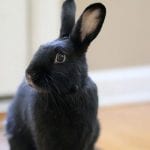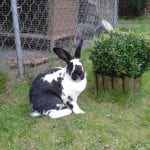Scientific Facts
| Common Name: | Giant Chinchilla |
| Scientific Name: | – |
| Life Span: | 7 to 10 years |
| Size: | 12 to 15 pounds |
| Habitat: | Domesticated |
| Country of Origin: | USA |
Giant Chinchilla Information
Known all across America as that big, fluffy, and lovable chunk of fur, the Giant Chinchilla stands as one of the most successful and most popular breeds of rabbit due to how cute and cuddly this enormous rabbit is. An offshoot of the standard Chinchilla breed, the Giant Chinchilla is “Americanized” in the sense that American breeders found a need to make things bigger when it came to their rabbits.
More than a hundred years ago, the Chinchilla Rabbit was bred in France primarily because this large rabbit was a good source of meat and that its fur was also useful for commercial purposes. The same rabbit was introduced to America in 1919 and became a hit among American rabbit breeders. These American breeders wanted to create a bigger Chinchilla, which they called the American or the Heavyweight Chinchilla, which was introduced to the public right around the middle of 1924.
However, a breeder named Edward Stahl realized that he wanted something bigger than the already big enough American Chinchilla. He wanted something that was gigantic because he thought that it would have been a big hit to the American fur industry if he was able to produce a larger Chinchilla that still retained some of the original breed’s great qualities. As such, Stahl sought to cross the New Zealand Whites with other breeds such as the Standard Chinchilla and the American Blue to produce a product that has the same kind of appearance and qualities of the normal Chinchilla Rabbit but is far larger than the American Chinchilla.
It did not take too long for the Giant Chinchilla to gain some recognition among different rabbit breeders in America. It was in 1928 when the American Rabbit Breeders Association decided to recognize the Giant Chinchilla rabbit as an official breed. Since then, it has only grown in popularity and is one of the more favored rabbit breeds for pet owners not to make use of it in the rabbit fur trade but because of its overall appeal and demeanor as a domesticated pet.
Physical Description
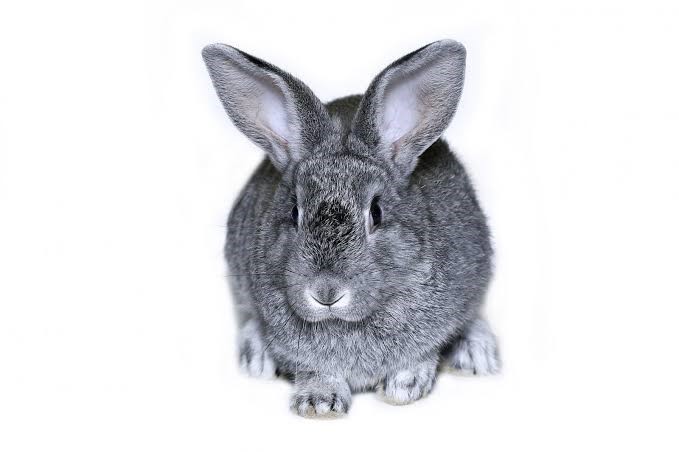
Being one of the larger rabbit breeds as suggested by the word “giant” in its name, the Giant Chinchilla is classified as a giant in terms of its size in the rabbit world. It should be big enough to weight somewhere between 12 to 15 pounds and is more than likely to be about thrice as large as the Standard Chinchilla. Its overall body type also makes it look bigger than other large rabbits as its body is not too compact and actually carries a semi-arched shape that is quite in proportion to its heavyweight. Female Giant Chinchilla’s are usually bigger and heavier than the males and can be about a pound heavier.
The ears of a Giant Chinchilla should more than likely be straight and erect and not falling down behind the rabbit eyes like the similarly-popular lopped-eared rabbits. Its ears are also quite long and should be longer than the length of the rabbit’s head. Meanwhile, in terms of how broad the ears are, you will notice that they are broader than most other rabbit breeds and can be up to two and a half inches wide at their broadest portion.
Due to how the Giant Chinchilla was specifically bred to be large and powerful as opposed to being simply fat and overweight, this breed features legs that are big and strong. It is difficult not to notice how powerful-looking its legs are since this rabbit was able to develop big and strong hindquarters by carrying its large frame and heavy mass. The feet are also just as strong and powerful as the legs are. Overall, this rabbit’s legs and feet are actually proportionate to the rest of the Giant Chinchilla’s body in terms of size.
Though the Giant Chinchilla was bred to be large and powerful and not too fat, it still features the same soft and round underbelly that most domesticated breeds of rabbits have. This gives this breed its fat-looking and cuddly appearance even though it may be more muscular than fat when compared to the other gigantic American rabbit breeds.
The coat of the Giant Chinchilla used to be the breed’s major selling point in the commercial market because of how it has a flyback coat, which is actually quite different compared to the rest of its cousins in the Chinchilla family of rabbits. But, even though its coat is different when compared to the other Chinchillas, it actually has the same maintenance requirements as any other breed of rabbit.
Giant Chinchillas are known to only have one standard color. The only type of Giant Chinchilla color that is recognized by the ARBA is the slate and blue coat that had made the Chinchilla family so sought-after back when the rabbit coat was still very popular in the commercial market. Usually, the Giant Chinchilla has a dark blue color near the base of its body but slowly transitions to a dark blue with gray shades near the top of the rabbit’s body. Meanwhile, the underside portion of its tail will almost always be white, while the topside is usually a combination of black and white.
Personality
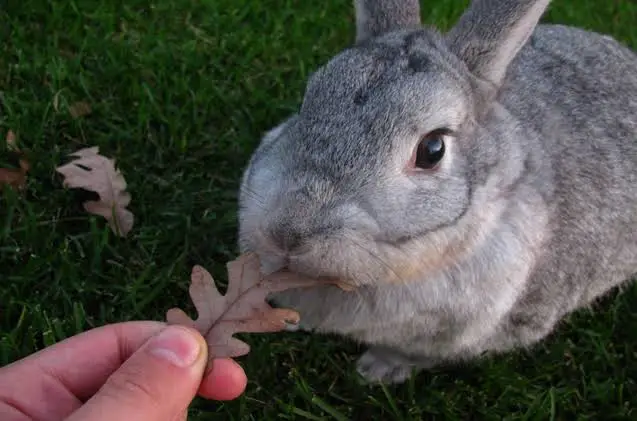
True to the rabbit’s name, the Giant Chinchilla really is gigantic and large enough for them to look so intimidating and dominant when compared to the other smaller rabbit breeds. However, do not let their size fool you as these rabbits are actually gentle giants that act like a big ball of fluffs. They are much more easygoing and friendly than what their size would suggest as different pet owners all around the world love having Giant Chinchillas around due to their overall demeanor and temperament as pets that are well-suited for any kind of domesticated household.
A very laidback breed of rabbit, the Giant Chinchilla is not a breed that likes to do a lot of stuff and would much rather prefer to stay with its owner. It is really just very easygoing but still friendly enough to want to feel some sort of attention or affection from its owner. They can be quite sweet and will oftentimes show its affectionate side to its owner. This makes it a good companion for any kind of owner to have as singles and couples like having such a big and fluffy ball of fur showing affection and sweetness towards them during a lazy and laidback afternoon at home.
During its younger years, the Giant Chinchilla needs to be exposed to a more social kind of setting for its sociable side to become more prominent as it gets older. You may want to try to spend some time with it outside of its cage for it to feel like you actually want to interact with it. And when it comes to children, it might not be the ideal type of pet rabbit to have for kids because of its large size, but it can get used to socializing with them as long as the Giant Chinchilla is exposed to children at an early age so that it will actually enjoy being around kids.
Female Giant Chinchillas are known to be really affectionate and caring mothers that show their natural maternal nature to their babies by attending to their needs as much as possible. But, despit3e that, you still should not expect them to be very outgoing or as attentive and as maternally caring as dogs are.
It is not expected for the Giant Chinchilla to be active as a breed. However, it might show a playful side whenever you try to foster that kind of personality. Having it exposed to rabbit-safe toys early will allow it to show a bit of playfulness. But, despite that, it generally is not very active and will most likely just like hanging around you instead of playing.
Giant Chinchillas can be quite docile even though they are really big rabbits. Personality-wise, it will be easy for you to try to handle this rabbit breed because of how generally submissive it is to human care. But the only problem you have when handling them is how to make them feel safe due to how difficult it is to carry them because of the breed’s gigantic size and frame.
Life Span
As hardy as the Giant Chinchilla is, thanks to its overall combination of different genes from different breeds, it is not too susceptible to a lot of conditions that rabbits are known to easily suffer from. This makes this breed a really hardy and resilient pet rabbit to have. However, there are still conditions that can be unique to the Giant Chinchilla.
One notable condition that you should be wary of is flystrike, which happens when its droppings get caught in its fur. This condition can be really painful and can even cause death when not treated right away. In that sense, always makes sure that its droppings are immediately separated from the rabbit’s habitat.
Other than that, ear mites, digestive issues, and overgrown teeth are some of the more common health problems that can affect the Giant Chinchilla’s lifespan. Always have its ears checked by a vet to make sure that it is free from mites or that its mite problems are treated right away. Food that is rich fiber such as hay can help it with its digestive problems. Also, hay can be a good way to make sure its teeth do not grow out of proportion.
It is expected for the Giant Chinchilla to have more or less the same lifespan as its other domesticated cousins. This rabbit will most likely live at least 7 years as long as you provide it with the minimal kind of care it deserves. However, if you have a pretty resilient and hardy Giant Chinchilla or if you take care of yours in the best way possible, there is no reason why it will not be able to live about 9 or so years.
Reproduction
Giant Chinchillas actually grow really rapidly and can reach sexual maturity faster than most other rabbit breeds. You can expect them to be sexually mature enough for reproduction right around 4 months old, but it might take a bit longer for some breeds. They are almost identical to any other domesticated rabbit when it comes to reproduction as they share a common ancestry. These rabbits will give birth to a litter size of about 2 to 7 rabbits. They can also reproduce multiple times in a single calendar year.
Behavior
Giant Chinchillas are known to be some of the most well-behaved rabbit breeds in the entire world. They give justice to their reputation as gentle giants because of how truly gentle and easygoing they are. They almost always prefer to stay laidback in terms of how they behave as these rabbits are known to be good-natured and kind regardless of who they are with or where they are.
Given how well-behaved the Giant Chinchilla is, it is not a troublemaker of a breed. It will not cause you problems due to how it just simply likes lounging around or seeking attention by cuddling with you. You almost will not see it doing things that active breeds of rabbits usually do as they prefer to just walk around from time to tie to stretch their legs or observing what you are doing with your own time. In that regard, it is not even the most demanding rabbit in terms of how much attention it requires. As long as you interact and socialize with it on a regular basis, you will not have a lot of trouble with this rabbit breed.
Since it is not very energetic, it is not the most playful type of rabbit, but it may play with you if it has gotten used to playing during its younger days. The safest way to play with this rabbit breed is to make sure you provide it with rabbit toys that are not too small for the large Giant Chinchilla. Another wise way of allowing it to play is to give it time outside of its cage and to make it feel a sense of freedom. In all other cases, trial and error might be necessary for you to find out the best way to play with your Giant Chinchilla.
Giant Chinchillas can be potty trained but are much more difficult to train than dogs and cats. Most rabbit owners prefer to potty train their Giant Chinchillas by using cat litter boxes and placing them all around the house so that the rabbit will associate the litter box with doing their business. As soon as you notice your Giant Chinchilla using the litter boxes, gradually decrease the number of boxes until you are left with one or two. It can be a challenge to train them to use a litter box, but it can also be one of the best moments of interaction between you and your Giant Chinchillas.
Eating Habits
Giant Chinchillas have the same kind of dietary needs as any other domesticated breed of a rabbit, but the one thing that you should take note of is that these larger rabbits have higher calorie requirements than most other breeds. That means that you should increase the portions of their meals or increase the regularity of their feedings.
When it comes to the usual composition of its meals, the Giant Chinchilla’s regular calorie intake should be primarily composed of hay. This type of food should make about 70% of the rabbit’s diet. The Giant Chinchilla should always have hay to chew on not only because of how large it is but also because constantly chewing on hay decreases the risk of teeth from overgrowing. Another thing to take note of is that hay is rich in fiber and will very much aid in your Giant Chinchilla’s digestive issues.
The rest of the 30% of your Giant Chinchilla’s diet should be composed of a combination of nutrient-rich rabbit pellets, leafy greens, vegetables, and fruits. Younger Giant Chinchillas should be allowed to eat a lot of rabbit pellets until they reach about a year old due to how they need it to grow as rapidly as possible. Meanwhile, when feeding your rabbit with vegetables and leafy greens, always go for the ones that are high in fiber but low in starch. Fruits should be limited because they are high in sugar. The number of fruits you should feed your Giant Chinchilla should be based on its overall weight.
Water
Giant Chinchillas require to regularly hydrate themselves even though they generally are not very active and energetic breeds. The importance of water for any kind of pet cannot be overstated as it is still better to have them starve than leave them for a few days without water. You need to make sure that your rabbit has access to a consistent source of water such as a water dish in their enclosure. Always keep an eye on the water and make sure to replace it as soon as you see any signs of contamination to avoid water-borne diseases and infections. Do not go for a water dish that is too large because any kind of rabbit does not like getting wet as it easily stresses them out.
Cage
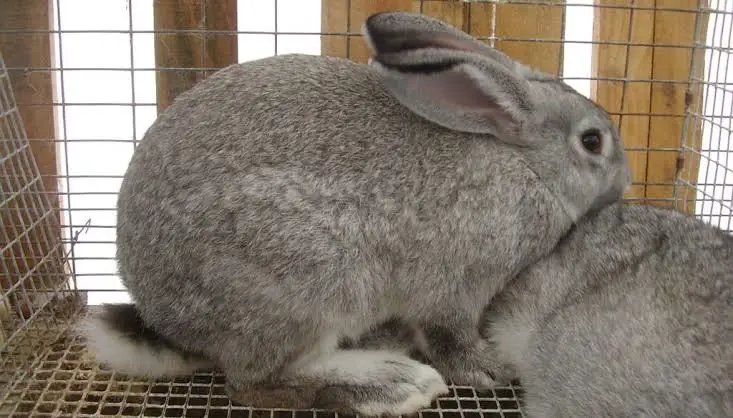
Like a lot of domesticated rabbits, a Giant Chinchilla can be housed outdoors if you prefer to do so. When housing them outdoors, the one thing you should first consider is the climate. Always make sure that the climate is well-suited enough for a pet to live in so that they will have no problems living outdoors. Also, see to it that there are no predators that are large enough to easily prey on your Giant Chinchilla. A wire fence that is high enough and a roof on top of the enclosure can deter predators from trying to get inside the Chinchilla Rabbit’s enclosure. The roof also safeguards it from the elements such as rain and the warmth of the sun during hotter days.
A good outdoor enclosure can be made out of wood and wires for fencing. The good thing about housing them outdoors is that they will be exposed to sunlight regularly and that they will have more than enough space to move around and stretch their legs. But the bad thing here is that they will be more exposed to predators and parasites and to the elements.
However, since there are still a lot of risks involved when you house your rabbit outdoors, an indoor cage is still the best option for you. A Giant Chinchilla’s cage should be a least 4 to 5 times its size. A good cage can be about 4 feet long, 3 feet wide, and 3 feet high. This can provide the necessary room your rabbit needs to feel a sense of freedom. The cage should be made of metal and should be sturdy enough to handle the weight of the Giant Chinchilla. The one thing that is important here is to make sure that the bottom is solid enough and is not made of wire. The Giant Chinchilla is a heavy rabbit, and having it stay on flooring made of metal wires can easily injure its feet.
Availability – Where to Get one?
Giant Chinchilla rabbits are actually very common in the US, even though they only have a global population of about 2,000. These rabbits can be searched and purchased from reputable breeders online with just a simple search on the internet. Most of these rabbits are not too expensive if you get them from the right breeder and can be had for a price that is somewhere between $40 to $60. Those without pedigree tend to be cheaper but, as long as you got them from a good breeder, it does not really matter whether or not they come from a championship line of parents.
How to Care for a Giant Chinchilla?
There are not a lot of special requirements for you to take note of when you are caring for a Giant Chinchilla. They are almost the same as any other breed of domesticated rabbits in the sense that the care requirements that need to be followed in regard to this breed really are just similar to most other rabbits. And the best part is that they are not very demanding and too difficult to take care of.
The size of the Giant Chinchilla’s cage is the first thing you need to take note of because they are really big rabbits that require you to house them in cages that are bigger than the standard ones so that they will have enough room to move around, feel free, and stretch their legs. Make sure the cage is sturdy enough and that it has a solid flooring to minimize the risk of injuries to your Giant Chinchilla.
Like any other breed of rabbit, the Giant Chinchilla does not like getting bathed. Bathing this rabbit will easily stress it out and may even cause death. As such, spot-cleaning is the best way to make sure that it stays clean. You can also have it groomed regularly by taking it to the groomers or by grooming it yourself. This breed is not too difficult to groom even though it has a flyback coat. It really simply follows the same grooming requirements of any other domesticated breed of rabbit.
FAQs
Are Giant Chinchillas ideal pets?
Because of how friendly and laidback the Giant Chinchilla is, it makes a good pet for any kind of owner regardless of their age and civil status. They make good pets for singles and couples alike.
Are Giant Chinchillas active pets?
Giant Chinchillas are known to be easygoing and laidback rabbits that are not too active or energetic.
For what purpose was the Giant Chinchilla bred for?
The Giant Chinchilla was first bred at a time when the original breeder thought that having a larger type of Chinchilla can be profitable in the rabbit coat industry.
Are Giant Chinchillas friendly towards children?
Children might find it difficult to handle Giant Chinchillas because of how big and heavy they are, but they are typically very friendly towards children as long as they grew up used to having kids around them.
What is the best way to interact with a Giant Chinchilla?
Other than handling them, one of the better ways for you to spend time and interact with your Giant Chinchilla is to allow it to stay close to you when it is out of its cage. These rabbits are not too fond of playing around and are better off just lounging around with its owner.
What colors does the Giant Chinchilla come in?
The Giant Chinchilla only comes in one color that is officially recognized. In that regard, they should only come in a slate blue color.
Is the Giant Chinchilla recognized by the ARBA?
It did not take too long for the Giant Chinchilla to gain recognition from the ARBA as it was in 1928 when it was officially recognized as its own breed by the American Rabbit Breeders Association.
